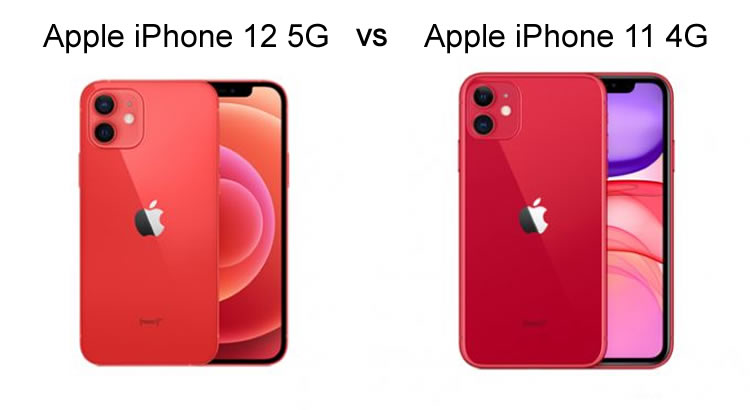
Of all the direct upgrades available with this year's iPhone family, there's no bigger step-up than the iPhone 11 to the iPhone 12. It's an advancement in most of the ways that matter, from design to display quality to network connectivity.
But just how much of an improvement are we talking about here? And does the outgoing iPhone 11 still hold any cards? Let's take a look at how Apple's most popular phone line compares in a generational face-off.
Compare iPhone 12 deals
Design
|
|
iPhone 12
|
iPhone 11
|
|
Size (mm)
|
146.7 x 71.5 x 7.4
|
150.9 x 75.7 x 8.3
|
|
Weight (g)
|
164
|
194
|
|
Materials
|
Glass front, glass back, aluminium frame
|
Glass front, glass back, aluminium fram
|
The iPhone 12 represents Apple's biggest design revamp in several years. Out go the curved frames of the iPhone 6 through to the iPhone 11, and back in come the flat surfaces and sharp edges of the iPhone 4 and iPhone 5.
In addition to being more angular than the iPhone 11, the iPhone 12 is considerably more compact. It's 11% thinner, 15% smaller and 16% lighter.
While both phones share similar materials - a glass front and back with aluminium frame - the iPhone 12 gains a new Ceramic Shield on its front. This improves the phone's drop resistance dramatically.
Despite sharing the same IP68 rating, the iPhone 12 is water resistant to an even greater depth than the iPhone 11. It's considerably more rugged all round.
Screen
|
|
iPhone 12
|
iPhone 11
|
|
Size (inches)
|
6.1
|
6.1
|
|
Resolution
|
1170 x 2532
|
828 x 1792
|
|
Type
|
Super Retina XDR OLED
|
Liquid Retina IPS LCD
|
|
Brightness (nits)
|
625 (typ), 1200 (peak)
|
625
|
Perhaps the biggest improvement here comes in the display department. Apple has finally ditched LCD technology altogether for its smartphone range, which means that the iPhone 12 gains the OLED panel technology formerly reserved for the Pro line.
OLED provides way more vibrant colours, superior contrast, and higher peak brightness, opening up the potential for true HDR output. OLED screens can also replicate true blacks, unlike backlit LCDs.
In addition, the iPhone 12 display packs in twice the number of pixels as the iPhone 11, with a resolution of 1170 x 2532 versus 828 x 1792.
Basically, aside from being the exact same size (6.1-inches), the iPhone 12 display is markedly better than the iPhone 11 display in every way.
Power
|
|
iPhone 12
|
iPhone 11
|
|
Processor
|
A14 Bionic
|
A13 Bionic
|
|
RAM
|
4GB
|
4GB
|
Apple makes the best mobile processors in the business, and while the iPhone 11 was fast, the iPhone 12 is even faster. The latter's A14 Bionic chip is the first to be built using a 5nm production standard, as compared to the 7nm standard of the iPhone 11's A13 Bionic chip.
That means that the A14 chip is inherently more power-efficient, opening the door for superior performance. Apple hasn't made too many direct claims about the relative performance difference between the two chips, but early benchmark tests appear to suggest an improvement of up to 20%.
Where Apple has made a direct comparison is with the A14's new 16-core Neural Engine, which apparently provides a 80% increase in machine learning performance over the equivalent A13 component.
Camera
|
|
iPhone 12
|
iPhone 11
|
|
Rear camera
|
12 MP f/1.6 wide, 12 MP f/2.4 ultrawide
|
12 MP f/1.8 wide, 12 MP f/2.4 ultrawide
|
|
Front camera
|
12 MP f/2.2
|
12 MP f/2.2
|
There doesn't appear to have been a major camera hardware overhaul from the iPhone 11 to the iPhone 12 at first glance. Both phones pack a pair of 12MP sensors - one wide, one ultrawide.
However, the iPhone 12's main wide sensor sports a wider f/1.6 aperture that lets 27% more light in, as well as a new seven-element lens. The combination of these components makes for superior low light performance, especially now that the iPhone 12 can use Night Mode on all of its cameras.
When it comes to video recording, the iPhone 12 also scores a new advantage in the form of Dolby Vision HDR video recording up to 30 fps.
Battery life, memory and connectivity
|
|
iPhone 12
|
iPhone 11
|
|
Battery size (mAh)
|
2815
|
3110
|
|
Onboard storage (GB)
|
64/128/256
|
64/128/256
|
|
Connectivity
|
5G
|
4G
|
The headline addition to the iPhone 12 is 5G connectivity. For the first time, Apple's smartphone can benefit from the blazing-fast speeds and low latency of the next generation network. What's more, the iPhone 12 can smartly switch between 4G and 5G depending on what you're doing.
In terms of stamina, the iPhone 11 would appear to score a rare victory here. Its battery is physically bigger at 3110 mAh versus 2815 mAh for the iPhone 12. But Apple is quoting identical performance under load from mixed media, which suggests that the iPhone 12 is a more efficient runner.
Storage options are identical across the iPhone 11 and iPhone 12, with a choice of 64GB, 128GB, and 256GB.
Compare iPhone 12 deals
Conclusion
The iPhone 12 represents a huge step up for Apple's popular mainline iPhone range. It's better looking and more compact than the iPhone 11, packs a far superior OLED display, as well as superior performance. Meanwhile its camera takes better low light photos and videos, and it's able to access the new 5G network.
It's true that Apple has bumped the iPhone 12's launch price up by £100 compared to the iPhone 11, but it's not hard to see where the money has been spent.





